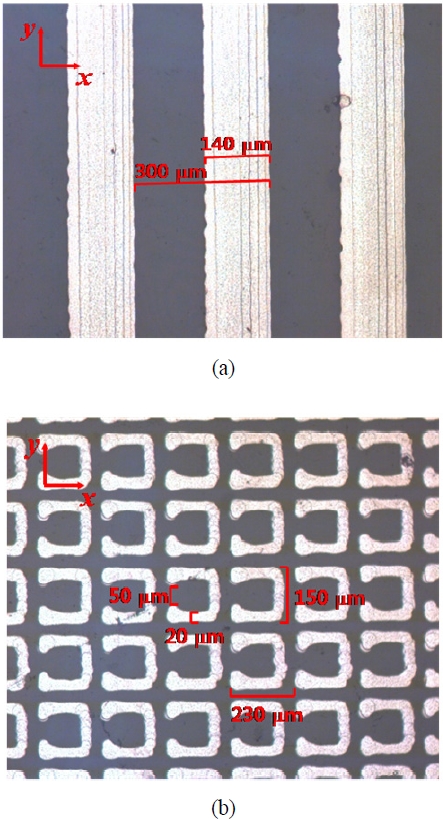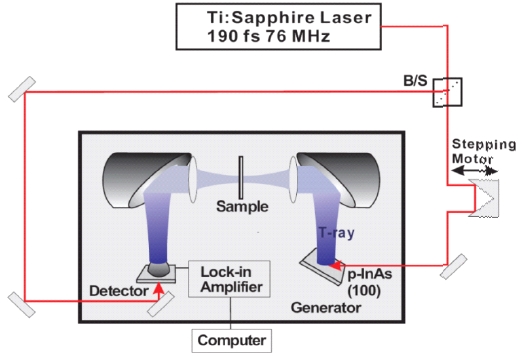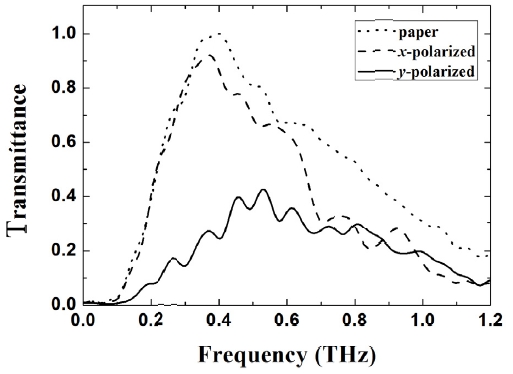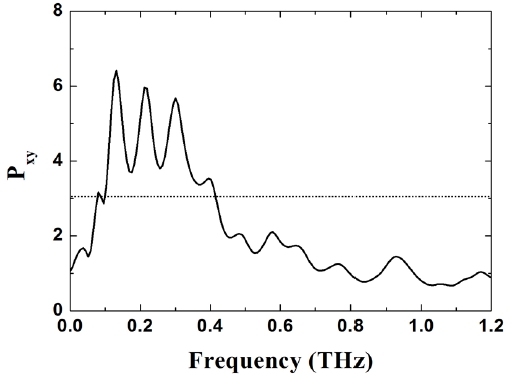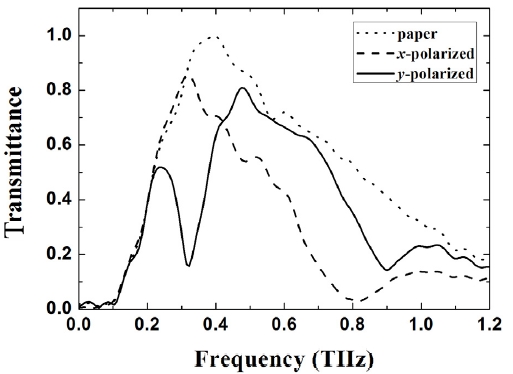



Terahertz (THz) waves are electromagnetic radiation with frequencies generally in a range of 0.1 to 10 THz, between the microwaves and the far-infrared [1]. Owing to recent advancements in optical and electrical components, efficient THz sources, detectors, and passive devices have been developed [2]. THz time-domain spectroscopy (THz-TDS) and THz imaging systems still demand suitable THz components for improving their performance.
Artificial periodic structures have been demonstrated to be useful in manipulating electromagnetic waves. The representative example is a photonic crystal which is periodically composed of materials with different dielectric constant [3]. Photonic crystals can improve the performance of optical devices such as waveguides, filters, light emitting diodes, and semiconductor lasers. Metallic periodic structures are also useful in improving radiation efficiency and patterns of antennas in microwave and millimeter wave ranges [4, 5]. Thus periodic structures are expected to be useful in manipulating THz waves and could act as functional devices in a THz frequency range [6-10].
Usually, planar metallic structures on solid or flexible films have been fabricated by a photolithography technique including nine steps: making a photo-mask, cleaning the substrate, spin-coating the photo-resist, baking, exposure, development, post-baking, metal evaporation (etching) and resist removal. The processes demand a long task time and high cost.
Recently, printing techniques have been widely used in fabricating electronic components on polymer films. The printing method has only 3 steps: cleaning substrate, ink-jet printing, and heating. The last process lets silver nanoparticles be sintered together and thus a printed sample becomes metallic. The printing method reduces processing time and effort for fabrication of planar Type metallic structures on films. Walter et al., reported THz transmission of periodic arrays of split ring resonators (SRRs) printed on a polyimide substrate with ink including silver nanoparticles [11]. Hangyo et al., also reported fabrication of wire-grid structures and SRRs on high-resistiviTy Si substrates by using a super-fine ink-jet printer with silver paste ink [12]. The printed structures act a good polarizer and filter. Thus the printing method can be useful in fabricating periodic structures to work in a THz range. It is interesting to print the periodic structures on conventional photo-papers to have no absorption in a THz range. A photo-paper is also flexible as well as cheap. Moreover, surface treatments such as plasma or ultrasonic cleaning are not required, unlike Si-substrates and polymide substrates.
In this paper, we report fabrication of a one-dimensional arrays of metallic wires and two-dimensional arrays of metallic SRRs by using an ink-jet printer and a conductive ink with silver nanoparticles. The structures were printed on a conventional photo-paper. The THz spectral responses are measured by a home-made THz-TDS system. The measured spectra show that the metallic wire array can act as a THz polarizer and the SSR array can act as a THz band-stop filter in a certain THz range.
A high-dpi (dots-per-inch) resolution drop-on-demand printer and a conductive ink were employed to fabricate metallic periodic arrays on a conventional photo-paper. We printed a one-dimensional array of wires on a general-purpose photo paper with an ink containing silver nano-particles (DGP-40LT-15C) by using an ink-jet printer (DMP-2831). The samples were placed on a hot plate at 130℃ during 30 minutes for the sintering of silver nano-particles.
The feature resolution of a printed structure depends on a nozzle to jet ink drops and compositions of ink. We have tried to find conditions to give a good feature resolution by varying both the weight percent of Ag in the ink and temperature and bias-voltage of a nozzle. After a lot of trial and error, we achieved 20 μm-feature resolution that is good for printing periodic arrays to work in a THz frequency range under the conditions that temperature and bias-voltage of a nozzle are about 30℃ and 16 V, respectively, and the weight percent of Ag is 32.0. However, printed arrays with 20 μm-feature resolution do not exhibit metallic properties because few Ag nano-particles are sintered in printed 20 μm-lines. To improve probabiliTy of sintering between Ag nano-particles, we iterated printing on the same place maintaining the 20 μm-feature resolution. We have found that four iteration printing is enough to make structures which exhibit metallic properties.
Fig. 1(a) shows the printed one-dimensional array of wires with a period of 300 μm and width of 140 μm. A two-dimensional array of SRRs printed on the photo paper is shown in Fig. 1(b). The one side length of a SSR is about 150 μm. The line width and the gap size are about 20 μm and 50 μm, respectively. The period of the array is about 230 μm. The printed sample sizes are about 1.0 × 1.0 cm2.
Fig. 1(a) shows the printed one-dimensional array of wires with a period of 300 μm and width of 140 μm. A two-dimensional array of SRRs printed on the photo paper is shown in Fig. 1(b). The one side length of a SSR is about 150 μm. The line width and the gap size are about 20 μm and 50 μm, respectively. The period of the array is about 230 μm. The printed sample sizes are about 1.0 × 1.0 cm2.
Fig. 3 shows the transmission spectra of the one-dimensional wire array for THz pulses with polarizations perpendicular (
To test the abiliTy of our sample as a THz polarizer, we calculated the ratio of transmittances of
Fig. 5 shows the transmission spectra of a two-dimensional array of SRRs for the
The SRR structure has been also modeled to be a
A one-dimensional array of wires and a two-dimensional array of split ring resonators were printed on a photo-paper with an ink including silver nano-particles. The printed sample sizes are about 1.0 × 1.0 cm2. The transmission measured by a THs system shows that the arrays of wires and split ring resonators could act as a polarizer and a band-stop filter in a THz region, respectively. The printing method could be a tool to realize various structures for functional THz devices.
